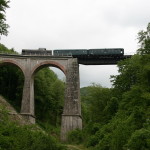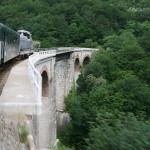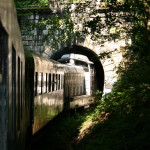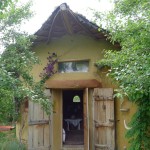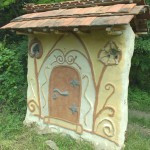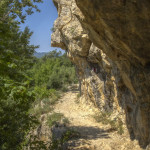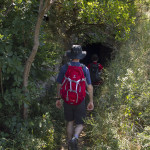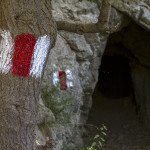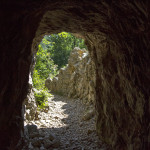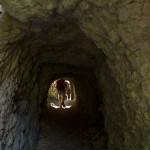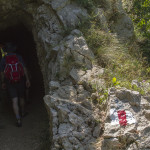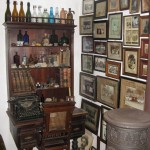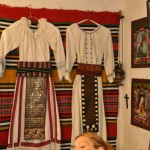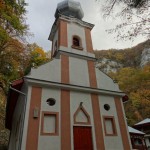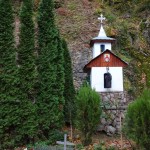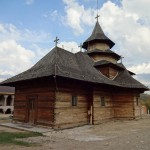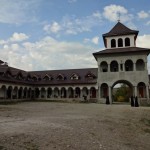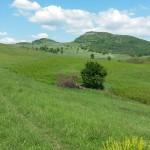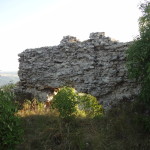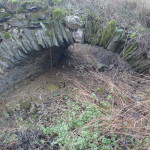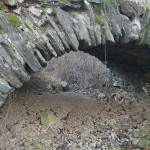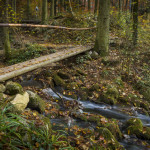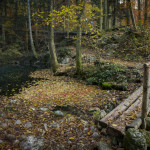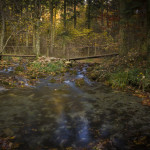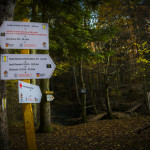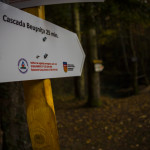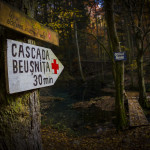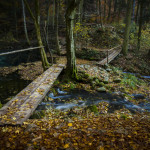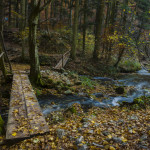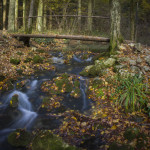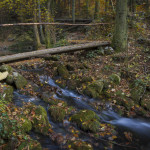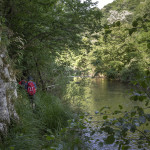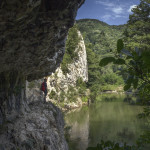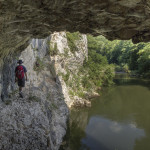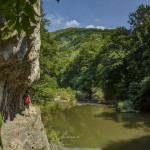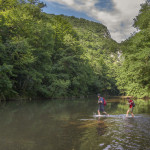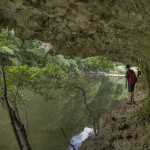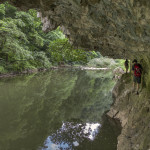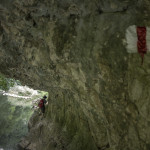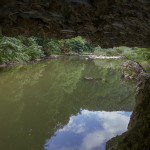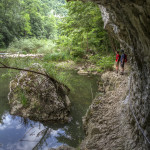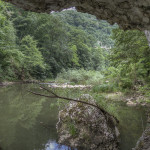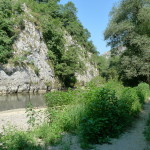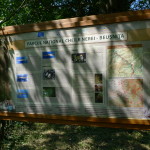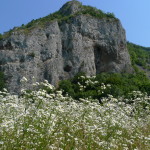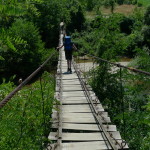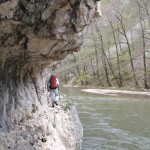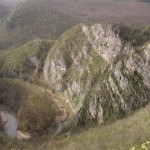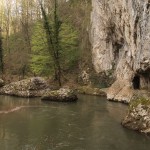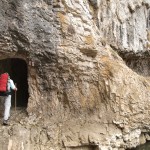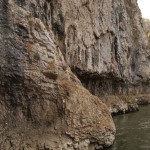[layerslider id=”7″]
Tourist attractions
Nature attractions
Nerei Gorge
The longest gorge in Romania (22 km between the villages of Șopotu Nou and Sasca Română) crosses a particularly spectacular karst area. The experience of hiking through this gorge, unique countrywide, includes areas of trekking through small tunnels or underneath rock walls, where the trail was cut into the side above the waters of the Nera River, as well as river crossings – hence the season and flow matter very much. When the waters are high (especially in spring), the river is ideal for rafting enthusiasts. The rich vegetation and fauna, with sub-Mediterranean influences, complement the wild landscape, where limestone walls hide caves and potholes. The most spectacular sector is the middle one, located between Dracului Lake (Lacul Dracului) and Damian’s Hut – the only actual stopover places along the gorge.
Beușnița Waterfall
Far from civilisation, in the heart of the mountains, at the foot of the wooded slopes, the waters of a creek form one of the most beautiful waterfalls in the Carpathians. Beușnița is a wonder in any season, whether foamy waves pass through the awning of green moss or huge icicles pierce it like lace.
Ochiul Beiului Lake
At the confluence of the Beușnița Creek (Pârâul Beușnița) with the Bei River (Râul Bei), a wonderful water mirror surrounded by fir trees gave rise to many local legends. The most popular one says that a wicked pasha ruled these places and he had an extremely handsome blue-eyed son. The boy fell in love with a Vlach’s daughter, but his father, who opposed it, had her killed. The legend has it that the lake was born of the bitter tears shed by the enamoured young man and that is has the colour of his eyes. Interestingly, this lake never freezes, as the water temperature remains constant throughout the year, between 4 and 8oC.
Dracului Lake (Devil’s Lake)
The underground lake in the cave bearing the same name was revealed by the partial collapse of its ceiling. The lake is fed by the waters of the Nera River either directly through a system of underground channels or through some of the flooded galleries of the cave; it is one of the largest karst lakes in the country, with an area of about 700 m². The maximum depth is almost 14 meters. The view it offers is impressive due to the suspended banks that support the lake and the blue-green colour of the water.
Șușara Gorge and Waterfall
At the southern end of the Sasca Montană village, a one-hour route on a path marked along the Șușara Creek (Pârâul Șușara) takes you through the wilderness to a beautiful waterfall.
Cultural attractions
The Mountain Architecture Ensemble – Sasca Montană
In the once cosmopolitan Sasca Montană, owing to the miner settlers brought here for work, you can see traces of bygone times in many of the old buildings. The Roman-Catholic church is witness to the prosperous times of this mining settlement, more of whose charm we can find by visiting the Victor Tăutu Museum.
The Ethnographic Museum of Sasca Montană (The Victor Tăutu Museum)
The museum is dedicated to the local history and culture and captures the evolution of this old mining settlement through a diversity of objects. The collection includes everything from geological samples and mining tools, illustrating the main occupation of the locals, to old photographs and stamps, traditional costumes and local ceramics. There is no sign pointing to the museum; it is located at number 345 and is open to visitors from May to October.
Casa Verde (The Green House)
Near Sasca Montană lies an experimental cob cottage, built with passion by a Romanian architect after returning from her experience abroad. Courses and workshops are conducted here regularly, where participants can learn techniques for building similar housing. Materials used – cob, stone and wood, are in perfect harmony with nature and the success of the project is proved by the increasing number of young people who want to learn from the Green House experience (http://www.casa-verde.ro).
The Tunnels (La Tunele)
One of the most spectacular sights of the Nerei Gorge are the tunnels carved into the rock wall in the segment between Sasca Română and Podul Bei. Apparently this work was carried out during the Ottoman occupation to facilitate the access of the troops along the border. The novelty of the trail is completed by the path carved into the rock, 15 m above the waters of the Nera River and by the suspended footbridge in Sasca Română.
Stăncilova – a traditional scattered Village
This is one of the most picturesque ridge villages of the Banat Highlands. The households stretch over a broad plateau, where the lives of several hundreds of locals blend harmoniously with the surrounding nature.
Ciclova Română Catholic Church (The Little Church on the Cliff)
The fate of the church built on top of the cliff is closely linked to the story of a very old icon of the Virgin Mary, known in these parts as Maria Ciclova or Maria Stâncii (Saint Mary of the Cliff). History says that, around the year 1700, two families of German settlers discovered this icon in one of the caves underneath the hill. The mystery of the icon has to do with the hermits that are said to have found shelter in the caves under this cliff during the Ottoman occupation. Traces of a Franciscan monastery were actually found in the cave where the icon was discovered, so, to honour the icon, the German settlers who found it built a little church on the cliff above.
Călugăra Monastery
Nestled under the Rolului Hills of Ciclova Montană, the monastery has a story full of wonders. Legend has it that around the year 1830, a shepherd heard church hymns coming from the woods. Surprised, he set off towards where the sound was coming from, thus reaching a cave where he found the icon of the Virgin Mary and the earthly remains of a hermit. It was believed that the icon had been brought all the way from Mount Athos and carried by the believers to the church in Oravița. The icon, however, would not allow itself to be carried away from the cave and kept reappearing, so it was decided to set up a chapel here, with the cave as foundation for the altar.
Nera Monastery
A relatively new settlement, established in 1994 with Saint Parascheva as its patron, the monastery soon became known all over the country thanks to the natural products made here by the nuns. The monastery is located in the Nera Valley, right outside Sasca Montană, and it is visible from the county road linking Sasca Montană to Slatina Nera.
The Ruins of the Medieval Fortress of Socolari, Bei Fortress
Bei (Begului) Fortress or the Medieval Fortress of Socolari was a fortification of which today only romantic ruins remain on top of the hill, offering a panoramic view of the Oravița Depression. The wall here reminds us of the period during which Banat was an Ottoman pashalic (17th century).
The Old Roman Road
The Romans wanted Dacia for its underground riches, and the mining in this area has been mentioned in historical documents ever since the year 120 A.D. The main access road built by them through the Danube Gorge was supplemented over time with a few secondary roads on both banks. A few fragments of these roads are still preserved today, winding from Sasca Română, an old mining centre, to Șopotu Nou, on the Cameniței Valley (Valea Cameniței).
The Oravița-Anina Railway
Also known as the Banat Semmering thanks to its similarity in terms of construction difficulties to the Austrian Semmering railway, this is the first mountain railway in present day Romania. It was built using Austrian techniques between 1860 and 1863, when Banat was under Austrian domination. The section has a length of 33.8 km, 14 tunnels and 10 viaducts and an elevation gain of 340 m. We recommend this train ride for the outstanding views it offers. Useful travel information: www.cfrcalatori.ro
Mihai Eminescu Theatre – Oravița
Oravița is also home to the first theatre in present day Romania, inaugurated in 1817, when Banat was celebrating a centenary since its liberation from the Ottoman administration. It is the first theatre building in Europe to be lit with acetylene lamps and the interior decorations are an exact copy of the Vienna theatre. Some of the most important theatre companies of the time performed on its stage: the Royal Theatre Company of Madrid, the Bolshoi Theatre of Moscow, the Imperial Orchestra of Russia, as well as illustrious companies from Vienna. Its current name marks the visit of Mihail Pascali’s theatre company in 1868, where Mihai Eminescu was a prompter at the time.
The Knoblauch Pharmacy Museum – Oravița
The oldest mountain pharmacy in the country is impeccably preserved today as a museum in Oravița. The collection consists of pharmaceutical furniture and instruments dating back from the 17th century (1682) to the 1950s and supplemented by an archive and the Francisc Klima – Ionel Bota library of old books.
The Imperial Mint Museum – Oravița
The Museum tells the story of the Ciclova Montană Mint, where Austrian Kreuzers were coined for almost half a century (1811-1855). At the time, the Banat Highlands (Oravița included) were under the domination of the Austrian Empire. Wishing to take advantage of the wealth of the copper mines in the area, the Court of Vienna ordered the establishment of a mint here, where some of the brass coins of the Empire were to be produced.
Numismatics enthusiasts can admire hundreds of coins and banknotes here, as well as documents and photographs of the time that tell the story of the minting activity in this part of the former Austrian Empire.
The three museums in Oravița can also be visited during a guided tour (theatre-pharmacy-mint) available only for groups.

